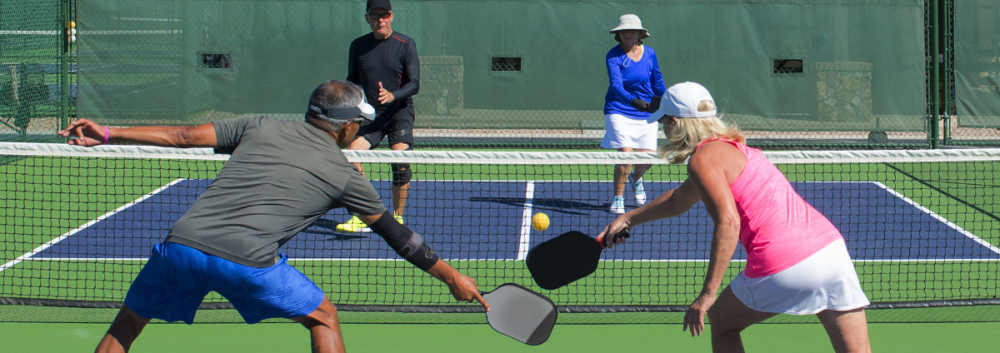The drop shot, where the ball dips over the net and lands in the kitchen or near the kitchen line, is one of the most important and powerful shots in pickleball. Your opponent has to play the ball below net height and lift the ball rather than try to attack it. The drop shot can be played from anywhere in the court and for a variety of purposes. It can be played against pairs that are slow to get to their kitchen. It can be used to reset a rally when you are being attacked and driven back. And, of course, a dink from your kitchen line is a drop shot. It is also a common shot played by experienced players when they are the serving team. Having served, they have to stay back to allow the bounce of the return of serve before they can play their second shot (which is the third shot of the rally). The so-called third shot drop.
This drill practices drop shots from different positions on court, specifically in order to advance from the back of the court, through the transition zone and up to the NVZ line. This requires 2 players. Player number 1 stands at their kitchen line and acts as the feeder. They feed player number 2, the ‘student’ who starts at their baseline. These roles are reversed at some point, after so many feeds or so many minutes. This drill can be played down one half of a court so 2 pairs can drill on the court at the same time. It could make part of a good warmup for instance.
To start the drill the player 1 stands near their kitchen line and hits a friendly shot to player 2 who is at the back of the court. Player 2 plays the ball after the bounce and lifts the ball to fall short in or near player 1’s kitchen. The ball doesn’t have to land in the kitchen but ideally should be short enough to make player1 play the next feed from below net height. Player 2 should advance up the transition area to play the second feed that should be another friendly shot back to them. Player 2 then plays a second drop shot (which should be easier as they are closer to the net) and continues to move up to their kitchen line. Having arrived at the kitchen line the rally is completed with a dinking dual. It may take more than 2 drops to get to the kitchen line. Playing 2 drops is quite usual.
A couple of things to remember. When you have to play a shot in the transition zone, pause your forward movement so you are stable when you hit your shot. This is likely to be below knee height and around you feet. It is hard to control shots from there if you are moving. You should also keep your paddle low. Ideally you play a lifted shot that reaches its apex before the net so that it is dropping as it goes over. (See the diagram at the end of this post on controlling the apex of your shot).
Both player 1 (the feed) and player 2 (the drop shot) can volley if the opportunity arises but should keep to the pattern of the drill. Depending on your position on the court and the shot you are receiving you should be able to play drop shots from anywhere on the court. None of this is easy to begin with. That’s why drills like this are useful. Repartition and grooving are the key.

https://oceansidepickleball.wordpress.com/2020/04/25/pallots-pandemic-pickleball-performance-post-5/
Notice that the further back in the court you aret, the higher the apex and the further from the net it has to be. It’s all about pace and height. For instance, playing drop shots from near your baseline, you need more height and the apex will be around your own kitchen line. When you are at your kitchen line, the apex is low and just above the net.
Note on the 3rd shot drop. The drop shot is the favoured 3rd shot in a rally, i.e. the serving team’s 2nd shot that is typically played from at or near their baseline while the opposing pair are already at their kitchen line. A good 3rd shot drop allows the serving team to get to their kitchen line or at least make progress towards it. However, it is a difficult shot to play reliably and can go very wrong! This is why it is rarely seen in beginner games and relatively infrequently in intermediate play where it is more usual to drive the 3rd shot.
